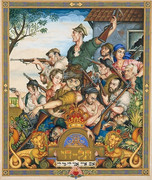A secular (or non-Haredi) revival in Ramot
0 Comments Published by Avi Green on Saturday, January 11, 2014 at 8:14 AM.
In Jerusalem's Ramot neighborhood, which became largely Haredi over the past 3 decades, there's been some improvement in gathering a more non-Haredi crowd of residents:
Only eight students will graduate from the sixth grade of the secular Mofet Ramot Alon school in Jerusalem’s Ramot neighborhood this year. Ten years ago there were several dozen of them, compared to almost 100 in the ‘80s. This may be yet another story of a dying secular school in a Jerusalem neighborhood that is growing increasingly ultra-Orthodox. In other neighborhoods undergoing this process, such schools inevitably close down and become ultra-Orthodox institutions.I'm glad the boycott of the mall fell apart. With any luck, the residents can overcome the awkward image of the neighborhood and get more non-Haredis to live there.
But Mofet Ramot Alon is in no danger of closing down and in recent years there have been signs of recovery in the neighborhood’s secular community. The sixth grade may have only eight students in it, but the fourth grade has 19 and the third grade 26. The happiest news for the neighborhood’s secular residents is the recent opening of a new secular kindergarten, when there was one for more than a decade.
The number of students in religious state-run schools in Ramot is also growing, as is the attendance in synagogues of the religious-national stream.
“We’ve received reports that synagogues where a baby crying hadn’t been heard for years are suddenly full of prams, both inside and out. It was a pleasant surprise,” says attorney Ze’ev Lendner, head of Ramot’s community council.
Pioneer of haredization
A giant neighborhood in north Jerusalem, Ramot was one of the first neighborhoods to turn ultra-Orthodox already in the ‘80s. By now the north of the city is seen as the capital’s ultra-Orthodox compound. All the neighborhoods around Ramot went ultra-Orthodox, sometimes within a few years and a large new ultra-Orthodox neighborhood, Ramat Shlomo, was built nearby.
Yet today, 30 years later, many secular people still live in the neighborhood and they say they’re not going anywhere. Unlike most Jerusalem neighborhoods, Ramot boasts a swimming pool that is open on Saturdays. A few months ago the secular community won a significant if symbolic victory when the ultra-Orthodox boycott on the local mall ended with a whimper.
The municipal election results show there’s a solid majority of ultra-Orthodox residents in Ramot. Altogether 71 percent of the neighborhood votes were for the ultra-Orthodox parties (although many non-Haredi people voted for Shas).
Many see the struggle over the Ramot shopping center last summer as the turning point in the neighborhood’s secular-Haredi relations. Seventeen ultra-Orthodox rabbis called on their followers to boycott the mall. Their main grievances were the saleswomen’s “immodest” dress and the music broadcast on loudspeakers.
At first the ban seemed to be working and very few Haredi shoppers came to the mall. Shop owners reported a sharp decline in sales. The secular public responded with a counter campaign, calling on Jerusalem residents from all over the city to come and shop there.
“The events that took place throughout the country in the summer of 2011 took place in Ramot in the summer of 2013,” says Gustavo Shneiberg, head of the Mofet school parents committee and a veteran social activist.
“People felt they could make a difference. We always said Ramot is an example of the wolf living with the sheep. Only we used to see ourselves as the sheep. Suddenly we’re the wolf,” he says.
The struggle succeeded and the boycott ended quickly without significant concessions by the mall’s management. Absurdly, the only shop that closed down following the boycott and did not reopen was a shop for holy scriptures. It was replaced by an ordinary book store.
One reason Ramot has not become ultra-Orthodox like its surrounding neighborhoods is its relatively high housing prices, which place it outside many Haredi families’ price bracket, residents say. Another is Mayor Nir Barkat’s decision to set up a separate community council for ultra-Orthodox residents. This prevented a Haredi takeover of the council, which in other neighborhoods marked the point of no return, residents say.
A considerable number of the ultra-Orthodox residents who moved to Ramot are known as “modern” Haredim who don’t mind living in a mixed neighborhood.
“I came to Ramot because it’s mixed,” says Bezalel Cohen, principal of an ultra-Orthodox school, who moved to Ramot six years ago. “The significant struggle in the neighborhood today is within the ultra-Orthodox community – between those who want to live [with non-Haredi people] and those who don’t. The ban on the mall is an excellent example for a campaign many ultra-Orthodox people didn’t like,” he said.
Image remains
But the secular residents’ biggest problem is Ramot’s image as an ultra-Orthodox neighborhood.
“Part of the image was created 25 years ago, when [Haredim] threw stones here and demonstrated against the swimming pool abomination,” says Hagit Hacohen Wolf, a religious woman living in Ramot for 30 years. “The neighborhood is changing but the image remains.”
This image is especially burdensome to Ramot’s only secular school. While recent [n]ational standardized student assessment tests (Meitzav) have repeatedly placed it as number one in the capital, the school finds it difficult to recruit students from outside the neighborhood.
“You can’t have a better track record than this school, but like the rest of the neighborhood it has this problematic image, which keeps people away,” says Shneiberg.
“This neighborhood is ahead of its time,” says Hacohen Wolf. “The processes taking place here occur later in Jerusalem and then in all of Israel. I’m talking about the demographic changes, the struggles and the solutions. If a secular person leaves Jerusalem to the state of Tel Aviv, he won’t have to face this problem anytime soon. But anywhere else he will and we have to tell ourselves we’re done with running away. If we have to give up in the end we will, but there’s still a long way to go.”
Labels: haredi corruption, Israel, Jerusalem, misogyny, Moonbattery









0 Responses to “A secular (or non-Haredi) revival in Ramot”
Post a Comment